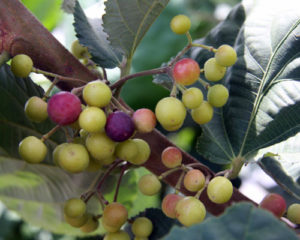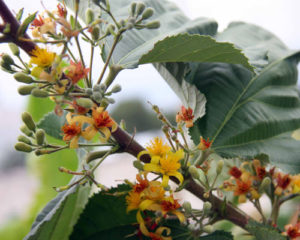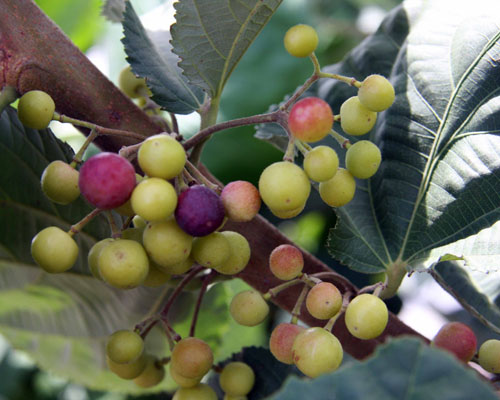
Looking for something unusual, exotic, tasty and good for you? Try the Sherbet Berry tree!
Also known as Phalsa (Grewsia asiatica), the Sherbet Berry fruit is popular in India for making refreshing fruit or soft drinks enjoyed during the hot summer months. The blueberry sized fruit has a pleasant tangy sweet sherbet-like flavor and is good for your digestion. The fruit ripens over a long season and is great for daily grazing or foraging walks through the garden. Deeba Rajpal has a wonderful Indian food blog “The Passionate About Baking†that explains it’s use and history as a popular beverage sold in the streets throughout Northern Indian, she also has some mouth-watering recipes for using this fruit:Â

LANDSCAPING WITH SHERBET BERRIES…Sherbet Berry trees grow from 12-15ft tall as a small tree or large, shaggy shrub.The trees are beautiful when it leaf with heart shaped foliage and bronze-red new growth. Â The blooms are a lovely bright orange-yellow and the fruit turns a purplish red, crimson or cherry red when ripe. As an edible landscaping tree, this beauty fits well as a specimen tree in small gardens. Combine it with ground covers of strawberries, or mixed seasonal greens to create stunning centerpiece garden. Planted closely together they create a beautiful short hedge, that is in flower and fruit all summer, but remember they often die back in the winter so are not the best choices for blocking unsightly views. Free of insects this plant is a good choice for organic growers.
The Sherbet Berry fruits are also nutritious. For a 100 gram serving, Sherbet Berry equates to these recommended daily requirements for an adult:
Vitamin A 10% (16ug)
Calcium 10% (136mg)
Potassium 8% (372mg)
Iron 6% (1.08mg)
Niacin (B3) 6% (.825mg)
Vitamin C 5% (4.385mg)
Phosphorus 3% (24mg)

Besides the fruit, Sherbet Berry bark and leaves also have medicinal properties. An infusion of the bark is used to reduce fevers and relieve minor pain and inflammation of mucous membrane. The leaves can be applied to skin eruptions and are known to act as an antibiotic.
GROWING SHERBET BERRIES…The Sherbet Berry will lose its leaves from a light frost and is deciduous even in mild winter climates (Zone 9) for 4-6 weeks. It prefers a change of season and doesn’t fruit well in areas without a distinct summer and winter. The Sherbet Berry has been grown successfully in Georgia in cold protected structures at the Fort Valley Agricultural Research Station. It is thought this new fruit may have some potential for small fruit growers in more northern climates that use tunnel houses in their growing operations. Here in North Florida have found the trees to be root hardy, bouncing back each year from the roots to bear a good crop. This fruits best possible outdoor range is zones 9a through 8b. More northern gardeners will have good success growing and fruiting them in containers. There are no known bugs or fungus issue, Sherbet Berry is a good choice for organic growers.

The trees are not fussy about soil types but it doesn’t like compacted or poor soils. If your soil is pure sand, plant it with manure and if you have too much clay, add some sand. Give it a good organic fertilizer and watch it grow!
Sherbet Berry is a vigorous, fast grower. While the trees are drought tolerant, you’ll need to give it consistent water for good fruit quality. The length of time from flowering to fruit ripening is only 45-55 days. Flowers only develop on the new shoots of the current growing season, once they begin fruit they will continue until frost. The Sherbet Berry typically starts fruiting on it’s the first year in the ground.
USING IN THE KITCHEN…To prepare the fruit for use. Soak in water for 30 minutes to an hour, this will soften the fruit. Drain and put in a bowl. Mash fruit to loosen the single seed in the center of the fruit, it helps to add water or other fruit juices create a slurry. Â Push this concentrate through a course sieve to remove the seeds. At this point, you can freeze the concentrate for future use or use right away. We like to sweeten it with honey or sugar and pour over crushed ice or added to smoothies.
This fruit definitely deserves a spot in the garden for it beauty as well as it’d bounty.

